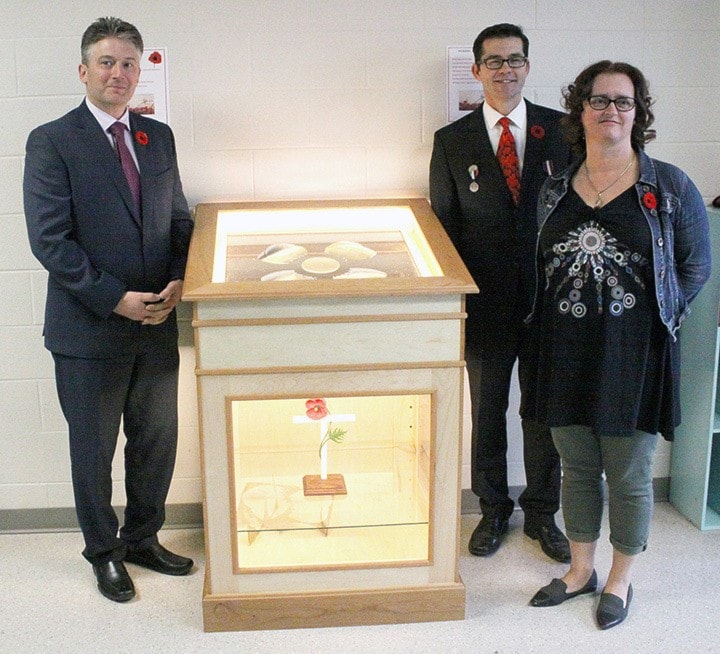A special project that has taken more than two years to complete has finally been unveiled.
A local artist has turned a 105mm artillery shell into a work dedicated to the memories of Canadian soldiers, spawned by thoughts from the local Member of Parliament and Ponoka Secondary Campus (PSC) social studies teacher Ron Labrie.
“It all began when I saw the memorial inlay in the floor outside the chapel at the Peace Tower on Parliament Hill in Ottawa,” explained Red Deer-Lacombe MP Blaine Calkins, who was at PSC Nov. 8 for the unveiling and to participate in the school’s Remembrance Day ceremony.
“(The memorial) has the names of all the First World War battles, some brass and rocks from some of the battle sites Canadians took part in. I talked to Ron and thought, if I could get my hands on a shell from Afghanistan, then maybe something could be done with it.”
Labrie loved the idea, and while it took some time for Calkins to lay his hands on the shell, he eventually did and Calkins stated it was great to see the culmination of everyone’s efforts.
The shell was then turned over from Labrie to Laeta Morskate, an artist and educational assistant at Ponoka Elementary School, who initially didn’t quite know what the final product would look like. Eventually, the shell would transform into a poppy inlaid into a slab of granite and encased in a wood and glass cabinet, which is built out of Canadian maple and cherry wood, constructed by PSC alumni and Skills Canada national champion Dustin Sjedl.
“Ron and I brainstormed for some time, but I always wanted to do something with what was donated around the poppy. The problem was how to deal with how to showcase it,” Morskate stated.
“Once I got the shell, we cut the back of it off and then shaped the rest into the poppy leaves. We used a water jet to cut out the leaves into a large piece of granite.
“The shell was flat, but then it began to come back to its original shape. It sort of brings it out more now and shows it has seen some life. As well, the front of the shell is thinner and shows what it’s been through.”
For Labrie, the project is something that looks simply amazing and will be a wonderful addition to the school’s Hall of Valour.
Remembering Vimy
The unveiling of the project was just the finishing touch on the day as students, staff and the public took part in the school’s annual Remembrance Day ceremony that morning.
This year’s ceremony was special in two ways — recognizing the coming 100th anniversary of the Battle of Vimy Ridge and the induction of another local soldier into the Hall of Valour.
Students from the Broncs World Tour, which this year will head to Europe from March 22 to April 1, organized the ceremony and created one of the video presentations that demonstrated the sacrifices and efforts Canadian troops put forth during the First and Second World War in addition to what took place on April 7, 1917 at Vimy Ridge. The service also included students holding lighted candles as a song was played to recognize the soldiers’ lives, what they gave and for those who have or continue to serve Canadians.
New inductee
The ceremony also marked the induction of Cpl. James Carey Pike in the Hall of Valour at the school, one of several soldiers who have a connection to Ponoka who died in the First World War.
Pike, originally from England, moved to the Ponoka area to be with his two brothers in 1907 at the age of 26. He had already been a member of the British Army, having earned medals for action in the Boer War. Once the First World War began, he returned and was killed as part of an effort to retrieve a fellow soldier from a bridge in France on Sept. 11, 1914, a mere three weeks after being posted to his unit.
Two PSC students that were on the Broncs World Tour last spring — Hannah and Brynne Louis — spoke to the crowd about the research they conducted on Cpl. Pike.
The pair stated that finding the evidence he made it to Ponoka as well as finding his name mentioned in the war diaries was the most satisfying thing about the research they did on the soldier.
